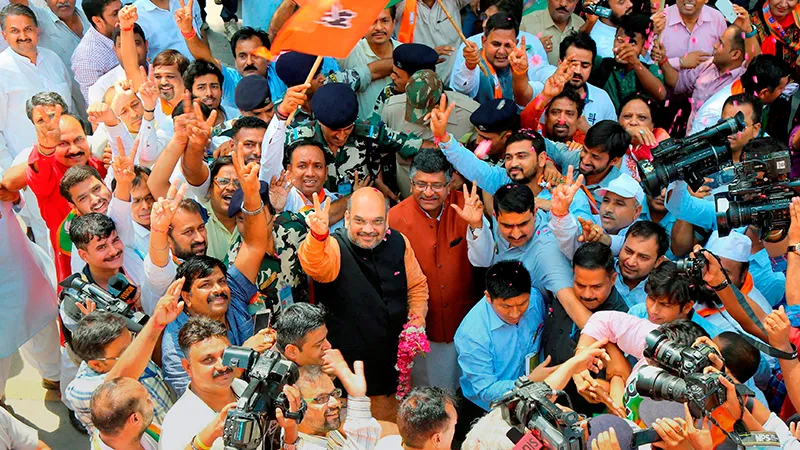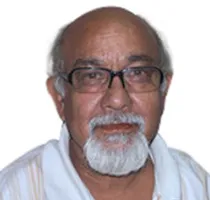-
CENTRES
Progammes & Centres
Location

The BJP’s spectacular victory in Assam has hogged media headlines and the media narratives strongly suggests that the BJP is on the upswing, increasing its electoral base across the country and the Congress is a shrinking force moving towards extinction. But, a close look at the data and electoral statistics does not tally with the broad media narrative.
It is true that the Congress lost power in two of the four states and one union territory where assembly elections were held — Assam and Kerala. A small consolation to the Congress leadership was the party wresting power in union territory of Puducherry from NRC. Also, there is no denying that the Congress has failed to arrest its downward journey. At the same time, it must also be noted that the grand old party was suffering from anti-incumbency factor.
In all, 824 assembly seats were at stake in these elections. The BJP has won 64 seats in all the five assemblies while the Congress has managed to retain 115 seats. The Left, which continues to be a much diminished national party, has won 105 seats in Kerala and West Bengal. Rest 540 seats have gone to regional parties.
The BJP’s poll percentage, compared to its performance in the 2014 Lok Sabha elections, has come down in most of the states barring Kerala where it has marginally improved. In West Bengal, it came down from 18% to 10.2%. In Assam, the BJP’s vote share in Assembly election stands at 29.5 per cent while in the 2014 Lok Sabha polls it had polled 36.50 per cent votes.
The Congress has 31% vote share in Assam while it had 29.60% in the Lok Sabha. In West Bengal, the Congress had 9.70% in the Lok Sabha while in assembly elections, it has polled 12.3% votes.
The BJP’s win in Assam has proved that its strategy for this particular state worked to help emerge a clear victor ending 15 years of the Congress rule in the state.
Learning its lessons from its electoral debacles in Delhi and Bihar, the BJP decided to underplay Prime Minister Narendra Modi and depended upon local leaders. It had appointed Minister of State for Sports Sarabananda Sonowal as the party chief in Assam last year. It had also forged alliances with the AGP and the Bodo Front while the RSS was kept in the shadows.
On August 23 last year, the BJP admitted three-time MLA and a prominent minister in the Tarun Gogoi cabinet, Hemanta Biswa Sarma, into the BJP. Sarma, who had rebelled against Chief Minister Gogoi, proved to be an asset for the BJP because he knew practically every weakness of the Congress and its leaders.
Now having entered Assam, the BJP is bound to make inroads in the other north-eastern states and the Assam polity will now begin to experience a new political engagement.
By opening its electoral account in the Kerala assembly, the BJP has registered its presence in a state where it had been striving for over three decades. However, it must be noted that the victory is of only symbolic relevance as it has won just one seat and that too largely owing to the respect its veteran leader O Rajagopal commands because of the good work done when he was a Union minister in the Vajpayee government. BJP’s vote share has gone up to nearly 15% which makes a good opening for the future elections. Here too, it must be noted that this is the first time the BJP, in alliance with the BDJS, put up candidates in most seats, while in 2011, the BJP had fielded only 40 odd candidates.
In West Bengal too, the BJP has increased its number of assembly seats to 3. It has gained two seats and its vote percentage has gone up hugely to 11% compared to 4.06% in 2011.
However in Tamil Nadu, the BJP, which had failed to strike any substantial alliance with any of the Tamil party, has not been very successful. It had alone contested on almost all the 234 seats and registered a vote percentage of around two percent.
The Congress’ electoral performance in five assembly elections is dismal as it not only lost power in Assam and Kerala, but its alliance strategies in West Bengal and Tamil Nadu have not yielded desired electoral results. In West Bengal, where it had an electoral understanding with the left parties, the Congress has been able to retain its electoral base in north Bengal. It won 44 seats a marginal increase of two seats in the assembly compared to 2011 when it had won 42 seats in an alliance with the Trinamool Congress of Mamata Banerjee.
It is a cause of worry for the Congress in Kerala where its vote percentage came down. Further, the possibility of state politics converting from bipolar to three cornered has also increased. The Left Democratic Front was able to retain its polling percentage and as a result, the Congress may be forced to sit in the opposition longer than till now when it used to return to power every five years.
Experiment in West Bengal to go into an electoral understanding with the CPM-led Left Front has not produced the expected results as the Left has suffered more than the Congress. As a matter of fact, if the Left Front and the Congress had contested the election separately, then the TMC would have won the election hands down. The Left Front’s polling percentage has come down by almost 10% while the Congress polling percentage has improved notionally.
Beating the anti-incumbency, Chief Ministers of Tamil Nadu and West Bengal, Mamata Banerjee and Jayalalithaa, have retained powers. While Mamata Banerjee’s TMC has been successful in increasing its number of seats, Jayalalithaa has created a record of sorts by winning two successive elections after 1984.
Despite the AIADMK losing two dozen seats, the DMK-led alliance has not been able to win enough seats to wrest power though it increased its number of seats substantially.
The message from the five assembly election is clear and bold. Notwithstanding the BJP-led alliance victory in Assam, regional leaders have gained in political significance and no national party can afford to overlook them.
The two national parties, especially the BJP, would have to do tough bargaining with the regional satraps. The BJP government of Prime Minister Narendra Modi will have to handle leaders like Jayalalithaa, Mamata Banerjee, Nitish Kumar, Laloo Prasad, Mayawati, and Mualyam Singh Yadav with soft gloves to overcome the opposition from the Congress to some important bills like the GST in the Rajya Sabha.
The results are going to impact the national politics in a major way. A realignment of political forces at the national level to challenge the BJP in the 2019 Lok Sabha elections is due, but it would gain momentum after the assembly elections next year in Uttar Pradesh, Uttarakhand, Punjab, Goa and Manipur.
The views expressed above belong to the author(s). ORF research and analyses now available on Telegram! Click here to access our curated content — blogs, longforms and interviews.

Satish Misra was Senior Fellow at ORF. He has been a journalist for many years. He has a PhD in International Affairs from Humboldt University ...
Read More +